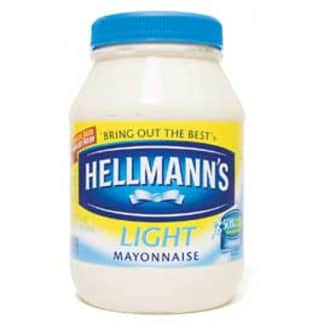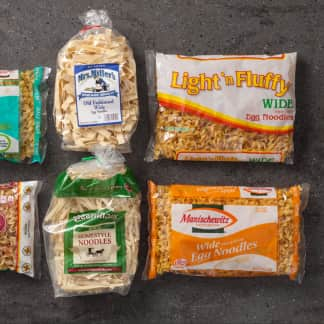In the test kitchen, we use cans of solid white tuna packed in water to make classic Classic Tuna Salad, where its firm texture is perfectly complemented by crisp minced celery and creamy mayonnaise, and Tuna-Noodle Casserole, in which its mild flavor pairs well with egg noodles and a rich roux. To find the best, we bought eight top-selling nationally available supermarket solid white tunas—what the industry calls “white” tuna is always albacore—priced from about $0.20 to about $1.10 per ounce. Six tunas were packed in water, while two were packed without additional liquid. Panels of 21 test kitchen staffers sampled the tunas plain and in tuna salad in two blind tastings, rating their flavor, texture, and overall appeal.
Tuna Shouldn’t Be Dry—Or Soggy
In both the plain and tuna salad tastings, one tuna stood out as superior; tasters found it “light and fresh,” “moist,” and “seasoned well,” with “lots of flavor,” but “not too fishy.” As we examined the ratings, we discovered that many otherwise acceptable tunas lost points for being too dry. “The flavor is good, but it feels wrung out,” wrote one disappointed taster. Products that tried to mask the fish’s dryness with vegetable broth or water were described as “mushy,” “watery,” or “soggy.” Tasters gave the lowest scores to tunas that were too “fishy” and had off-flavors.
So what made some tunas so dry? It helps to know how most tuna is processed for canning. After the fish is caught, it’s quickly frozen on the boat. At the cannery, it’s thawed and cooked, which makes it easier for workers to separate the meat from the bones. The meat goes in cans, and then some manufacturers add more ingredients such as salt, vegetable broth, water, and pyrophosphates (which help prevent mineral crystals from forming—something albacore is particularly prone to do). Finally, the can is sealed and sterilized at a high temperature. Manufacturers that follow this process are cooking the delicate fish twice; you’d never do this at home and still expect moist, tender fish. Adding water or broth doesn’t really help restore moisture, since these liquids can’t penetrate the tightly bound proteins—and our tasters noticed.

By contrast, two of the three higher-ranked tunas are cooked just once during processing, at the sterilization step. It’s a more time-consuming way to process tuna, but to our tasters, the results were worth it, with more flavorful, tender, naturally moist tuna. In addition, neither of these tunas contains added water or other liquid, so you get more tuna per can and don’t need to drain it as you normally would with water-packed tuna. These two products, which came in first and third place, are also pole caught using individual fishing lines (see Tuna Terms You Need to Know). Some experts say that pole-caught tuna is less stressed and therefore tastes better than tuna caught by more common commercial fishing methods, which trap and confine many more tuna—along with unwanted fish—in nets.
Our second-place tuna, by StarKist, which is currently the top-selling tuna brand in the United States according to Chicago-based market research company IRI, is traditionally processed. It may have won its ranking partially on its familiarity: Tasters wrote comments such as, “This one tastes like the tuna of my childhood.” It broke down into small shreds rather than chunks and was very moist (verging on “soggy” to some tasters). This tuna was appealingly “mild” and “sweet”-tasting and made “soft” (some said “mushy”), smooth scoops of tuna salad.
The Best Water Packed Solid White Tuna: American Tuna Pole Caught Wild Albacore
Our tasters’ overall favorite was American Tuna Pole Caught Wild Albacore, a tuna that is cooked only once, in the can, so it retained more of its natural moisture. No water is added; the small amount of liquid, which comes from the fish during cooking, should be stirred back in before you use it in recipes, no draining necessary. With the most sodium of the lineup, this tuna also struck tasters as “well seasoned.” While it’s the most expensive tuna we tasted, we think its flavor and texture are worth it.
- Mild and meaty
- Firm, with moist texture; not too hard or dry
- Well seasoned
- Large, intact piece of fish in can that breaks into sizable flakes
- No water added to can; no draining necessary
- Eight solid white albacore tuna products, packed in water or without added liquid, priced from about $0.20 to about $1.10 per ounce, selected from best-selling nationally available supermarket brands
- Products were purchased at local supermarkets and online
- Taste plain
- Taste in simple tuna salad with celery, red onion, and mayonnaise
- For comparison, sodium content is standardized and based on a 2-ounce (56-gram) serving
















